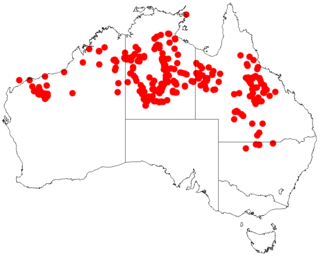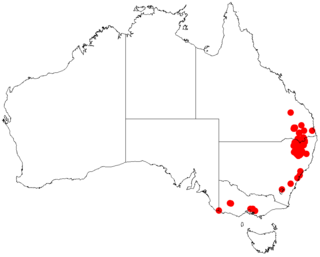
Velleia montana is a perennial herbaceous plant that is native to New South Wales, Victoria, and Tasmania in Australia, growing mainly in woodland and sub-alpine grasslands, and at higher altitudes south from Boonoo Boonoo. It has oblanceolate to obovate leaves that are 1.5 to 8 cm long and 6 to 30 mm wide. The yellow flowers have a 7 to 10 mm corolla. It blooms from November to February. The Latin specific epithet montana refers to mountains or coming from mountains.

Claoxylon australe, known as brittlewood is a common rainforest shrub or understorey tree. The habitat is all types of eastern Australian rainforests. The natural range of distribution is from Eden in south eastern New South Wales to Bowen in tropical Queensland.

Daphnandra johnsonii, the Illawarra socketwood is a rare rainforest tree in the Illawarra district of eastern Australia.

Arytera divaricata, known as the gap axe, coogara, coogera or rose tamarind is a forest tree of eastern Australia. An attractive plant with glossy pale and limp new leaves. It grows in fairly dry situations, often in littoral rainforests and monsoon forest.

Thysanotus tuberosus, known as the common fringe-lily is a perennial herb which is endemic to Australia. The species name tuberosus refers to the crisp tasting edible root.

Acacia cowleana, Halls Creek wattle, is a northern Australian native shrub. It is a flowering plant with yellow flowers that only open in winter. Its origin is the Northern Australia's dry tropics. It belongs to the genus of Acacia.

Pittosporum bicolor, commonly known as cheesewood or banyalla, is a flowering shrub or small tree of the Pittosporaceae family, and is native to south eastern Australia.

Psydrax oleifolia, commonly known as wild lemon or brush myrtle, is a species of shrub or small tree in the family Rubiaceae. It is endemic to eastern and inland Australia,.

Senna acclinis, the rainforest cassia or brush senna, is a flowering plant belonging to the Senna genus. The plant grows natively in New South Wales and Queensland in limited areas, where it has been classed as an endangered species.

Acacia pruinosa, commonly known as the frosty wattle, is a species of Acacia native to eastern Australia.

Zieria collina commonly known as hill zieria, is a plant in the citrus family, Rutaceae and is endemic to a small area in south-east Queensland. It is a large, spreading shrub with leaves composed of three leaflets, and small flowers with four white petals.
Isotoma petraea, commonly known as rock isotome, is a small, herbaceous plant in the family Campanulaceae occurring in arid regions of Australia. It has single, purplish-blue flowers on smooth, slender branches from February to November.

Hypericum japonicum, also known as matted St. John's-wort or Japanese St. John's wort, is an annual herb in Hypericumsect. Trigynobrathys.

Scaevola collaris is a shrub in the family Goodeniaceae and its native range is five mainland states/territories of Australia: the Northern Territory, New South Wales, South Australia, Queensland and Western Australia.

Xanthosia atkinsoniana, is a small herb in the family Apiaceae. It grows in both New South Wales and Western Australia.

Tetratheca glandulosa is a spreading shrub in the family Elaeocarpaceae. It is endemic to New South Wales.

Juncus antarcticus is a flowering plant species in the rush family Juncaceae, native to both New Zealand and Australia.

Asperula conferta is a species of flowering plant in the family Rubiaceae. It is Australian endemic distributed across Queensland, New South Wales, Victoria, Tasmania, South Australia and the Northern Territory.

Actinotus forsythii, is a plant in the Apiaceae family, native to the east coast of Australia, and found in New South Wales and Victoria

Persicaria prostrata, basionym Polygonum prostratum, is a species of flowering plant in the family Polygonaceae, native to Australia and perhaps New Zealand. It is known by the common name of creeping knotweed.




















